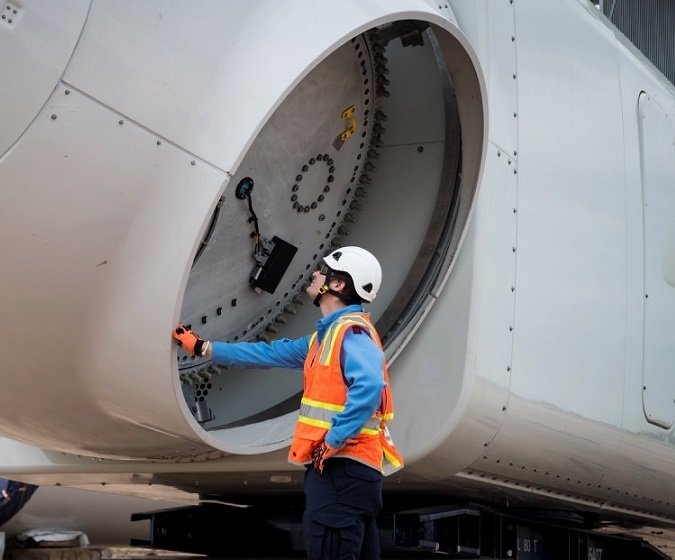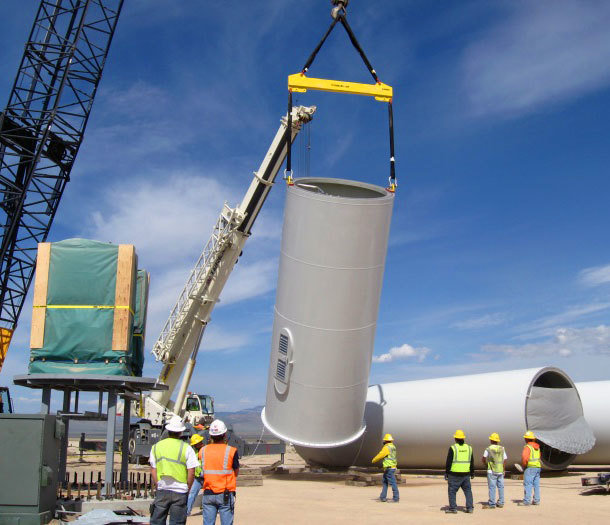1. Wind energy is cost competitive.


*Wiser, R.; Bolinger, M. 2017. 2016 Wind Technologies Market Report . U.S. Department of Energy.
Wind Energy Benefits
Photo from DOE Flickr 465 020 003
In 2016, the average levelized price of signed wind power purchase agreements was about 2.2 cents per kilowatt-hour. This price is cost competitive with new gas-fired power plants, and projected future costs compare favorably through 2040, according to the Energy Information Administration.*
2. Wind energy creates jobs.

*American Wind Energy Association. 2017. U.S. Wind Industry Annual Market Report, Year Ending 2017.
Wind Energy Benefits
Photo from Duke Energy
In 2017, the wind sector invested more than $11 billion in the U.S. economy to build projects and employed more than 105,500 workers.*

3. Wind energy helps to diversify the national energy portfolio.


Wind Energy Benefits
Photo from DOE Flickr 431 002 011
It's also an indigenous, homegrown energy source that helps stabilize the cost of electricity and reduces vulnerability to price spikes and supply disruptions.
4. Wind energy provides income for farmers and ranchers, as well as economic benefits to communities.

**American Wind Energy Association. 2017. U.S. Wind Industry Annual Market Report, Year Ending 2017.
**U.S. Department of Energy. (2015). Wind Vision: A New Era for Wind Power in the United States.
Wind Energy Benefits
Photo from Ruth Baranowski, NREL 16411
Revenue varies by region, but wind projects provide the communities in which they are located lease payments to landowners (~$3,000-$6,000/megawatt*), state and local tax revenues (~$7,000/megawatt), and employment.**

5. Wind energy is an inexhaustible renewable energy source.

*American Wind Energy Association. 2017.
U.S. Wind Industry Annual Market Report, Year Ending 2017.
**U.S. Department of Energy. (2015).
Wind Vision: A New Era for Wind Power in the United States.
Wind Energy Benefits
Photo by Nebraska Public Power District, NREL 1644
Wind energy is plentiful and readily available, and capturing its power does not deplete our natural resources. At the end of 2017, nearly 89 gigawatts of wind energy were installed across the United States.* Analysis indicates that by 2020, the installed capacity of wind energy in the United States could reach 113 gigawatts, or 10% of annual end-use electricity demand.**

6. Wind turbines don’t consume water.

*American Wind Energy Association. 2017. U.S. Wind Industry Annual Market Report, Year Ending 2017.
Wind Energy Benefits
Photo from DOE Flickr 431 007 010
Researchers estimate that wind power generation in 2017 reduced power-sector water consumption by 95 billion gallons, an amount equal to approximately 719 billion bottles of water.*

7. Wind energy is clean.

Wind Energy Benefits
Photo by Iberdrola Renewables, NREL 16692
Electricity generated by wind turbines does not pollute the water we drink or the air we breathe, so wind energy means less smog, less acid rain, and fewer greenhouse gas emissions. If we increase wind power’s contribution to the eastern grid by 30%, we could reduce carbon production by almost 19%.* **
*Study based on Eastern interconnection wind penetration increase in 2024, compared to 2008 levels.
**EnerNex Corporation. Revised February 2011.
Eastern Wind Integration and Transmission Study
. Prepared for the National Renewable Energy Laboratory.

8. Wind energy systems have low operating costs.

Wind Energy Benefits
Photo from DOE Flickr
This is because unlike other resources, there are no associated fuel costs with this form of generation.

9. Wind energy can be used in a variety of applications.

Wind Energy Benefits
Photo by Northern Power Systems, NREL 16728
Utility-scale, distributed, community, small wind and remote applications can be used for schools, tribes, municipal utilities, rural electric cooperatives, homes, businesses, farms, ranches, water pumping, ice making, and telecommunications sites.

10. Wind energy is deployed in all U.S. regions and is widely supported.

Wind Energy Benefits
Growth in wind power capacity over the 2007–2017 period averaged nearly 7.2 gigawatts per year.* A 2015 Gallup poll showed that more than 70% of Americans believed the United States should place more emphasis on wind energy development.**

*American Wind Energy Association. 2017. U.S. Wind Industry Annual Market Report,
Year Ending 2017.
**Gallup. 2015. U.S. Support for Nuclear Energy at 51%.
11. High levels of wind energy can be integrated with minimal cost increases while providing environmental benefits.

Wind Energy Benefits
Research has shown that high levels of wind and solar can reduce net carbon emissions by one-third with only a 2% to 5% cost increase.*

*National Renewable Energy Laboratory. (2013). The Western Wind and Solar Integration Study Phase 2.
For more details about the benefits of wind energy, visit the WINDExchange website.

Wind Energy Benefits

Photo by First Wind, NREL 16737
